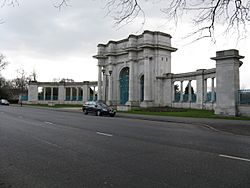City War Memorial, Nottingham facts for kids
Quick facts for kids City War Memorial, Nottingham |
|
|---|---|
| United Kingdom | |
 |
|
| For Men of Nottingham who died in the First and Second World Wars. | |
| Unveiled | 11 November 1927 |
| Location | 52°56′04″N 1°08′27″W / 52.934492°N 1.140752°W |
| Designed by | T. Wallis Gordon |
The City War Memorial in Nottingham, England, is a special monument. It remembers the brave people from Nottingham who lost their lives in the First World War and Second World War. This memorial is a large arch made of Portland stone. It has three openings with fancy iron gates. It also has stone walls on each side.
The memorial was officially opened in 1927. It stands next to a park that looks over the River Trent. In 1972, it became a Grade II listed building. This means it is an important historical building that needs to be protected.
Contents
Why Nottingham Built a War Memorial
After the First World War ended in 1918, people in Nottingham wanted to remember those who served. About 40,000 men from Nottinghamshire fought in the war. Sadly, around 10,000 of them died.
In 1919, leaders in Nottingham held a meeting. They discussed ideas for a city war memorial. People suggested many things. Some ideas were building a university or making the city's hospital bigger. Others thought about a statue or a special building.
Funding the Memorial Project
A public fundraising effort began. The goal was to raise money for the Nottingham General Hospital. Two important local business owners helped a lot. Sir Jesse Boot from Boots the Chemist and William Goodacre Player from John Player & Sons gave a lot of money.
Sir Jesse Boot also donated land for the memorial. This land was by the River Trent, south of the city center. In 1922, the city council announced a plan. The land would become a large public park, about 36 acres (14.6 hectares). The park would have a special memorial gateway.
The whole project was planned to cost about £70,000. Some money came from the government. They wanted to help unemployed men find work on the project. This way, the memorial helped the city in more ways than one.
Who Designed the Memorial?
The memorial was designed by T. Wallis Gordon. He was the City Engineer and Surveyor for Nottingham. He worked for the city from 1896 until 1935.
What the Memorial Looks Like
The main part of the memorial is like a triumphal arch. It is about 14 meters (46 feet) high and 18 meters (59 feet) wide. It has four tall columns. These columns are in a style called Doric.
The arch has three openings. Each opening has beautiful wrought iron gates. Above the gates, there are curved metal designs.
Details of the Archway
The middle archway is the largest. It is about 8 meters (26 feet) high and 5 meters (16 feet) wide. The city's coat of arms is part of the metalwork above its gates.
The two smaller arches on the sides are about 6 meters (20 feet) high and 2.5 meters (8 feet) wide. Above these side arches, dates are carved into the stone. On the left, it says "1914-1918" for the First World War. On the right, it says "1939-1945" for the Second World War.
Above the central arch, there is a Latin phrase carved into the stone. It says "VIVIT POST FUNERA VIRTUS." This means "virtue outlives death." The city's coat of arms is also carved above this phrase. Inside the archway, there are bronze plaques. These plaques have special messages. One plaque has words of praise from a French general, Marshal Foch, about the Sherwood Foresters soldiers.
The Side Walls
On each side of the main arch, there are curved stone walls. These walls are about 6 meters (20 feet) high and 26 meters (85 feet) long. They have iron railings between the stone columns. The total length of the memorial, including these walls, is over 70 meters (230 feet).
When it was first built, steps led down from the memorial to the River Trent. These steps were moved after the Second World War. Today, the central arch still lines up with a decorative pond in the memorial gardens.
History of the Memorial
The memorial was built on the east side of a new area called the Memorial Garden. This garden is also a listed historical site. It is located on Victoria Embankment, next to the River Trent.
The first stone for the memorial was laid on August 1, 1923. This was done by Edward, Prince of Wales. He later became King Edward VIII. There were some delays because of the large amount of ground work needed.
The memorial was finally opened on November 11, 1927. The Mayor of Nottingham, Edmund Huntsman, officially unveiled it. A special service was held by James Gordon, the Vicar of St Mary's Church, Nottingham. Thousands of people attended the ceremony. Soldiers from the Robin Hood Battalion also marched in a parade.
Later, the memorial was updated. This was to remember those who died in the Second World War as well. In 1972, it was officially listed as a Grade II building.
New Great War Memorial
In 2019, a new Great War Memorial was unveiled nearby. This new memorial is a 5-meter (16-foot) high stone pillar. It is surrounded by a raised stone ring. This ring has slate panels. These panels are etched with the names of 13,501 people from Nottinghamshire. These are the people who died in the First World War.
This includes civilians who died in a Zeppelin raid in 1916. It also includes people killed in an explosion at a shell factory in 1918. This new memorial was created by the Nottingham City Council and Nottinghamshire County Council. They worked with several local councils to make it happen.
Images for kids







